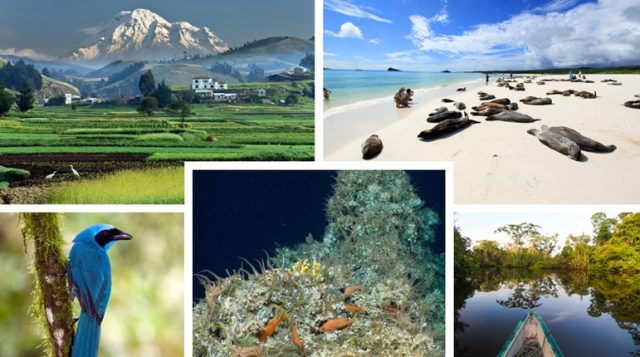
Despite its modest size, Ecuador is among the 17 most megadiverse countries on Earth offering four spectacular regions (the coast, Andes, Galápagos, and the Amazon) with pristine beaches, mountain ranges, volcanic archipelagos and rainforests teeming with wildlife. A deepwater scientific expedition has recently found a previously unknown coral reef with abundant marine life off Ecuador’s Galápagos Islands. A discovery that came about ahead of World Environment Day, it showcases the destination’s rich biodiversity and the numerous programmes in place to protect endangered life in this part of the world.
With a unique location crossed by the equatorial line that divides the northern and southern hemispheres, Ecuador hosts 10% of the world’s species of plants and more than 1,680 species of birds roaming the skies – 16% of the world total. Visit this October, to witness the beautiful solar eclipse!
Galápagos
With the recent launch of David Horwell and Pete Oxford’s guide to the Galápagos, travellers can really get under the skin of one of the most diverse corners of the planet, guided by their expert knowledge after decades of travel to the archipelago. The 19 Galápagos islands and islets are uniquely located on both sides of the equator at a point where three ocean currents collide, around 1,000km west of the mainland Ecuadorian coast – it is one of the few places on earth where the human footprint is kept to a minimum.
The climate is hot and humid in the north, with fertile land and plentiful vegetation, whilst the southern islands are harsh and arid. Due to the differing island habitats, several species, including tortoises, finches and land iguanas, have evolved in a different way to those on neighbouring islands, forming sub-species – this is what Charles Darwin discovered when he visited the islands in 1835, inspiring his Theory of Evolution. Due to this biodiversity, these islands have been called a unique ‘living museum and showcase of evolution’. Tourists are recommended to visit with a naturist guide to learn about the wildlife and conservation – highlights include marine lizards, sea turtles, giant tortoises, and Galápagos penguins.
Amazon
Although the Galápagos Islands often steal the limelight as Ecuador’s biggest nature attraction, Ecuador’s rainforest is regarded as the most species-rich section of the Amazon. Ecuador’s Amazon Rainforest is home to truly astounding biodiversity, with more than 300 species of mammal, 800 species of fish and 350 species of reptile.
Tourists should head to the Yasuní National Park, thought to be the jewel in Ecuador’s Amazonian crown. Covering 9,820 square kilometres, the park is the most well-known protected area of the Ecuadorian Amazon with as many as 100 different species of tree per acre, iconic animals such as jaguars, caimans and marmosets and 600 species of birds, constituting one third of all Amazon bird life. Highlights include macaws, toucans, tanagers and hummingbirds. The Taromenane and the Tagaeri tribes live in deliberate isolation in the Yasuní National Park, eschewing all contact with the modern world. They are instrumental in protecting the land, and their rights – including the right to be left alone – are protected by Ecuador’s constitution.
Andes
Two distinct chains of mountains form Ecuador’s Andean highlands, with lush green valleys nestled in the middle – home to alpacas and llamas. In this region, travellers can enjoy vast landscapes full of lakes, turquoise volcanic lagoons and natural sources of thermal waters. The mountains, as well as hosting some of Ecuador’s most enticing cities, such as World Heritage Quito and Cuenca, also boast the snow-capped Chimborazo Volcano – the closest place on earth to the sun (6268m). This is one of the highest mountains with non-technical routes – making it perfect for less seasoned climbers. Visitors can choose between a 2,4 or 5-day trek, and the summit offers stunning views from the roof of Ecuador.
Coast
Ecuador has 2,237km of Pacific coastline, with sandy beaches, rolling waves for surfing and the freshest seafood. Visit Machalilla National Park, one of the country’s few protected coastal regions, boasting tropical dry forest leading directly onto pristine beaches. Isla de la Plata, 25 miles off the coast sees humpback whales converge on these waters between June and October, after their 4,000-mile voyage to the warm pacific waters – the longest migration made by any mammal. Here, they are in the ideal climate for mating and giving birth to live young – a sight to behold for avid whale watchers.





